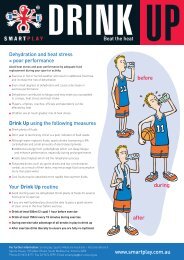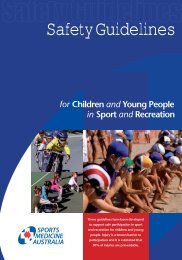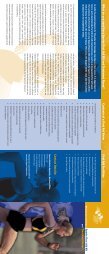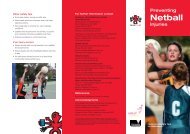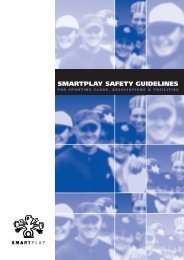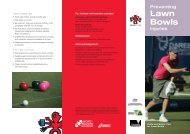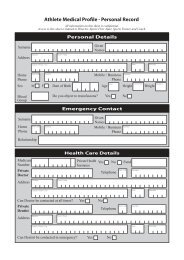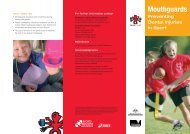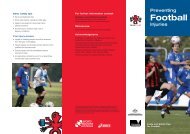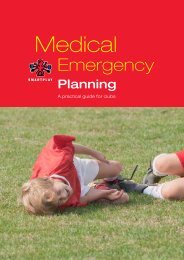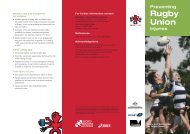Preventing Injuries Basketball.pdf - Smartplay
Preventing Injuries Basketball.pdf - Smartplay
Preventing Injuries Basketball.pdf - Smartplay
Create successful ePaper yourself
Turn your PDF publications into a flip-book with our unique Google optimized e-Paper software.
Other safety tips<br />
• NEVER hang or swing on a basketball ring.<br />
• Eat a well-balanced diet.<br />
• Drink water before, during and after play.<br />
• Do NOT play in extreme heat or wet conditions.<br />
Where possible games should be rescheduled.<br />
• Coaches, players and parents should be aware of<br />
heat illness symptoms.<br />
• Qualified first aid personnel, first aid kits, ice packs<br />
and a stretcher should be available at all times.<br />
• Telephone access, to contact emergency services,<br />
is essential.<br />
If injury occurs<br />
• Injured or bleeding players should be removed from<br />
the court immediately.<br />
• Injured players should seek prompt attention from<br />
qualified first aid personnel.<br />
• Ensure players are fully rehabilitated before<br />
returning to play.<br />
• A brace should be worn for at least three months<br />
after serious joint injuries.<br />
For further information contact<br />
<strong>Smartplay</strong> - Sports Medicine Australia<br />
(Victorian Branch)<br />
Sports House, 375 Albert Road,<br />
South Melbourne, VIC 3205<br />
Phone: 03 9674 8777<br />
Email: smartplay@vic.sma.org.au<br />
Website: www.smartplay.com.au<br />
<strong>Smartplay</strong> is supported by VicHealth,<br />
Sport and Recreation Victoria and the<br />
Department of Human Services.<br />
<strong>Basketball</strong> Victoria<br />
Box 3, Melbourne Sports & Aquatic Centre,<br />
Aughtie Drive, Albert Park VIC 3206<br />
Phone: 03 9927 6666<br />
Email: enquiries@basketballvictoria.com.au<br />
Website: www.basketballvictoria.com.au<br />
Victorian Injury Surveillance Unit<br />
Monash University Accident Research Centre<br />
Building 70, Wellington Road, Clayton, VIC 3800<br />
Phone: 03 9905 1805<br />
Email: visu.enquire@general.monash.edu.au<br />
Website: www.monash.edu.au/muarc/visu<br />
Sport and Recreation Victoria<br />
Level 14, 1 Spring Street, Melbourne, VIC 3000<br />
Phone: 03 9208 3333<br />
Email: info@sport.vic.gov.au<br />
Website: www.sport.vic.gov.au<br />
References<br />
Sherrard J, Cassell E. Systematic review of the<br />
effectiveness of strategies and measures to prevent<br />
community level basketball injuries. Report to Sport<br />
and Recreation Victoria, Monash University Accident<br />
Research Centre, Melbourne, 2006.<br />
Acknowledgments<br />
This updated fact sheet is funded by Sport and Recreation<br />
Victoria, Department for Victorian Communities.<br />
Prepared by Deakin University 1998. Updated<br />
by Monash University Accident Research<br />
Centre and reprinted 2007.<br />
<strong>Preventing</strong><br />
<strong>Basketball</strong><br />
<strong>Injuries</strong><br />
Facts and Safety<br />
Tips for <strong>Basketball</strong>ers
Facts on basketball injuries<br />
<strong>Basketball</strong> is one of the most popular sports in<br />
Australia with players of all ages and skill<br />
levels participating.<br />
Statistics from the Australian Sports Commission’s<br />
2004 survey showed an estimated 508,000<br />
Australians aged 15 years and older played<br />
basketball in the 12-month period prior to<br />
being surveyed.<br />
<strong>Basketball</strong> is a dynamic game of speed with<br />
frequent and aggressive body contacts that can<br />
result in injury.<br />
How many injuries?<br />
• From 2002-2004, basketball injury statistics recorded<br />
907 Victorian hospital admissions and 3,426<br />
emergency department presentations.<br />
• From 2002-2003, one in every 523 basketballers was<br />
admitted to a Victorian hospital.<br />
• The rate of injury for basketballers is 14 injuries per<br />
1,000 hours played.<br />
The causes and types of injuries<br />
• Common causes of injuries are falls, player contact,<br />
awkward landings, abrupt changes in direction and<br />
being hit by the ball.<br />
• <strong>Injuries</strong> to the lower body, namely ankle sprains, are<br />
most common.<br />
• Previous ankle injury, wearing shoes with air cells in the<br />
heel and not stretching during warm up increases your<br />
risk of ankle injury.<br />
• <strong>Injuries</strong> to the hand, fingers, head, face and teeth are<br />
also common.<br />
• Knee injuries account for the most time lost in training<br />
and games.<br />
• Females are at higher risk of knee injury than males.<br />
• Overuse injuries are most common in higher level<br />
players due to the duration and intensity of play.<br />
Safety tips for basketballers<br />
Good preparation is important<br />
• Undertake training prior to competition to ensure<br />
readiness to play.<br />
• Always warm up, stretch and cool down.<br />
• Undertake fitness programs to develop strength,<br />
balance, coordination and flexibility.<br />
• Gradually increase the intensity and duration of<br />
training as this will help reduce the risk of injury.<br />
Good technique and practices<br />
will help prevent injury<br />
• Know the rules and play fairly.<br />
• Learn and practise correct passing, jumping, landing<br />
and shooting techniques.<br />
• Be aware of the dangers of using basketball<br />
equipment inappropriately.<br />
• Know your physical capabilities and choose activities<br />
appropriate to your fitness level.<br />
• Coaches and officials should undertake regular<br />
certification and education to ensure their injury<br />
prevention knowledge is kept up-to-date.<br />
• Officials should enforce game rules.<br />
Wear the right protective equipment<br />
• Wear a mouthguard, preferably custom-fitted,<br />
at all times.<br />
• Wear shoes designed specifically for basketball.<br />
• Consider preventive ankle bracing if involved in<br />
jumping and rebounding frequently or if you have<br />
a history of ankle injury.<br />
Check basketball environment<br />
for hazards<br />
• Check and maintain the playing surface to remove<br />
hazards e.g. stones, wet surfaces.<br />
• Backboards and baskets should be of a high<br />
standard and securely mounted.<br />
• Backboards, their supports and walls should be<br />
suitably padded.<br />
• Baskets and boundary lines should not be<br />
too close to walls and fixtures. Refer to FIBA<br />
rules at www.basketballvictoria.com.au for<br />
further information.<br />
• If installing a ring at home ask a suitably qualified<br />
person such as a building professional to assess<br />
the safety of your installation.<br />
• Do not fix a basketball ring or backboard<br />
to brickwork.<br />
Modify rules and equipment<br />
for children<br />
• Juniors should be matched for competition on<br />
physical maturity and skill level.<br />
• Encourage children to take part in Aussie Hoops<br />
Oz Ball and Skill, Fun & Play programs, as<br />
well as the McDonald’s ® Hoop Time program<br />
to develop good skills and techniques.<br />
Photograph provided by <strong>Basketball</strong> Australia



